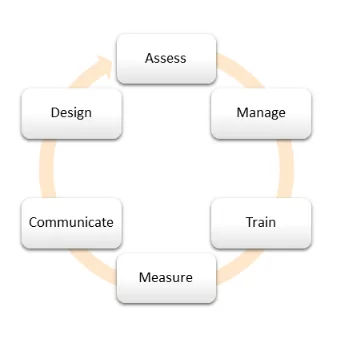If you’ve been following our blog lately, you’ll already have a good understanding of organizational change management, what it means, and the models that are a good fit for your business strategy.
In the last installment of our change management series, we will be looking at how to build out your own change management process, as well as the change management tools that can make implementing this process a whole lot easier. Let’s dive right in! (For more information, see our Guide to Business Continuity Plans.)
Table of Contents
ToggleCreating your own Change Management Process
Each stage of your change management process will need its own specific tools, so understanding the stages is a really important precursor to choosing the right technology and support. Take some time to think about each stage and what it means for you. Remember, in an ongoing change management journey, these steps will be cyclical.
Assess: Pinpoint specifically what needs to be changed, and complete change impact analysis, readiness assessment and planning.
Manage: Align leadership on the new direction, and manage stakeholder expectations and goals for the new changes.
Train: Think: who is going to be impacted the most by these changes? Set up knowledge transfer, and organize change coaching where it’s needed.
Measure: Measure the success of your changes by your own specific parameters, from ROI, compliance, or time savings, to company morale.
Communicate: Recognize how to communicate the need for additional change within your company at every necessary level.
Design: Choose how these changes are going to be put into place, utilizing your change management center of excellence to build out a plan.
Using These Stages to Pick the Right Change Management Tools
Now that you’ve created a change management process for your project, it’s a whole lot easier to see where the gaps are. Hone in on exactly the areas you need to augment with technology, education, or change management tools, and it will be a whole lot easier to get the support that you need to make it happen. Let’s look at a few examples.
Culture Mapping for Effective Communication
Understanding how to communicate effectively across an organization is no easy task, but culture mapping can be a great way to get there faster, and with intelligence rather than guesswork. Start by naming the subcultures in your organization. This could be teams or departments, such as IT, Sales, or Marketing, or it could be types of people, such as Legacy staff, Millennials, Remote workers, and more. Now choose representatives that you feel speak for each group accurately.
Start talking! Interviewing these representatives will help you understand what their goals and fears might be, what organizational blockers they need to get past, and what success looks like to them. Once you’ve noted down how they feel, you can use this as a launchpad for the ‘Communicate’ and ‘Manage’ parts of your change management process.
Train and Measure Using an Engagement Platform
Keeping to the cyclical nature of any change initiative means having your finger on the pulse of what your staff are feeling and thinking about the new projects you’re undertaking. One way to show your teams that you’re serious about feedback is by utilizing some kind of collaborative platform such as HowSpace. Employees are encouraged to document how they’re feeling about new changes, and everything can be used to feedback into the product or organization to improve any given solution. Create discussions, polls, tasks and more – and manage your change management from end to end.
Other change management tools to look out for include the Change Compass, a great data visualization technology that maps the impact of any change in terms of risk, market growth, or operational efficiency. It can be really effective when it comes to less practical measurements.
Assess with Incisive Visibility and Control
Of course, your bottom line has to be being able to see what the impact of a change will be, assess dependencies and complete impact analysis beforehand, as well as following through after the fact and measuring the differences, for example when handling a cloud migration or a merger or acquisition. That’s why the cornerstone of a change management process is your hybrid dependency mapping, one core centralized place where you can see all of your IT ecosystem at a glance, from cloud based deployments, to VMware, on-premises servers and systems, and all the dependencies of how these work together.
This change management tool might be the most important investment you make. The right one will help you to complete essential extras, such as right-sizing your instances for a migration, or drilling down into specific dependencies for impact analysis.
Here at Faddom, we love helping customers with a complex change management roadmap, so why not give us a call, and we can show you just how simple we can make it for you.









